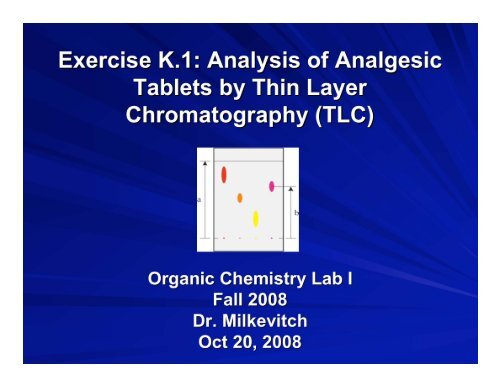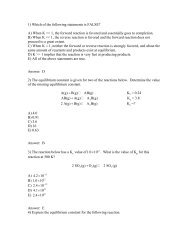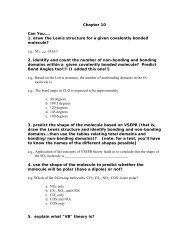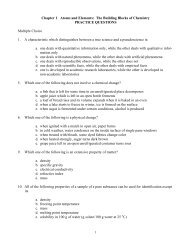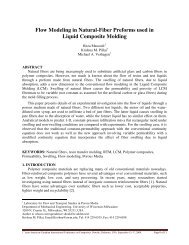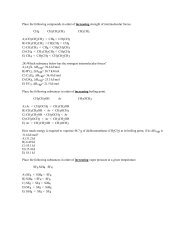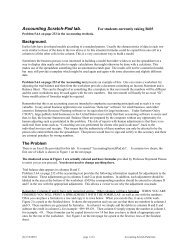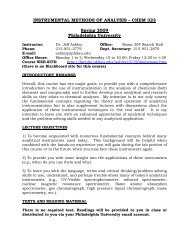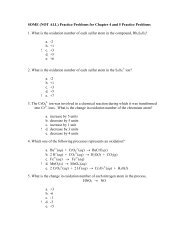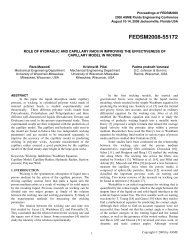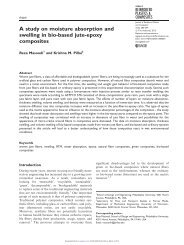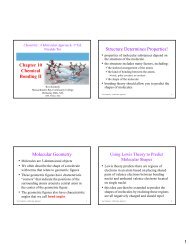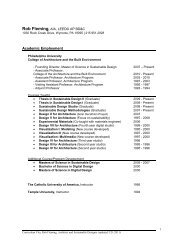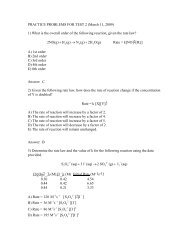Exercise K.1: Analysis of Analgesic Tablets by Thin Layer ...
Exercise K.1: Analysis of Analgesic Tablets by Thin Layer ...
Exercise K.1: Analysis of Analgesic Tablets by Thin Layer ...
- No tags were found...
Create successful ePaper yourself
Turn your PDF publications into a flip-book with our unique Google optimized e-Paper software.
Separating MoleculesToday: : Learn a separation techniqueMolecules can be separated <strong>by</strong> a number <strong>of</strong>methods:– Extraction– Precipitation– ChromatographyChromatography = “to write in color”– Originally developed to separate components <strong>of</strong> inks
<strong>Thin</strong> <strong>Layer</strong> Chromatography<strong>Thin</strong> <strong>Layer</strong> Chromatography: “The separation <strong>of</strong>moderately volatile or nonvolatile substances based upondifferential adsorption on an inert solid (stationary(phase)immersed in a organic solvent or solvent mixture (mobile(mobilephase)”Makes use <strong>of</strong>:– A stationary phase: : solid support– Mobile phase: a fluidBasic principle <strong>of</strong> separation:– Differential interactions <strong>of</strong> molecules with these 2 phases
How the separation worksMolecules can move with the mobile phaseOr, they can remain fixed on the stationaryphaseCalled partitioningHow molecules partition between the 2phases depends on:– Properties <strong>of</strong> the phases– Properties <strong>of</strong> the molecules being separated
How this works, continuedMolecules that partition into the mobilephase:– Will move more rapidly than molecules that partition intothe stationary phase– Therefore, they will separate from those that are partitionedinto the stationary phaseFaster moving componentpartitioned more intomobile phaseSolvent movementSlower moving componentpartitioned more intostationary phaseTwo component mixtureapplied to TLC plate
“Nuts and Bolts” <strong>of</strong> the MethodYou must carefully select mobile and stationaryphases to achieve full separation <strong>of</strong> mixtures <strong>of</strong>moleculesStationary phase: thin layer <strong>of</strong> silica spread on asurfaceMobile phase: solvent system that migrates throughthe silicaSamples are spotted on the plateMoved along <strong>by</strong> the solvent(s) migrating through thesilica
R f ValuesMolecules that are separated will migrate as “spots” and theirmigration can be measuredMigration usually reported as an “R f ” valueCalculation <strong>of</strong> an R f value:– Ratio <strong>of</strong> sample migration (how far spot moved) to solventmigration (how far the solvent moved)Can be used to identify components in a mixture– Compared to standardsToday: look at the components <strong>of</strong> analgesic tablets <strong>by</strong> TLC– Look for the “actives”
<strong>Analgesic</strong> Medications“Analgesia”: Greek for the deadening or absence <strong>of</strong>pain without loss <strong>of</strong> consciousness– <strong>Analgesic</strong>s: compounds that relieve painRange from aspirin to morphine, and other relatednarcoticsMany OTC (over the counter) analgesics available– Tylenol– Advil– Excedrin– Aspirin (various preparations)
ActivesOOHOTC analgesics containmany compoundsThe “active” is whatrelieves painOther compounds arebinders, flavorings,colorants, stabilizers,solubility enhancersNParacetamol (acetaminophen)Ibupr<strong>of</strong>enNNNNOOHOOCaffeine
ProcedureObtain a silica gel plate from me– This plate will have a UV indicator in itDraw a straight line (lightly, in pencil) approximately 2 cm from thebottom edge <strong>of</strong> your TLC plate. Use a ruler to do this. This is calledthe origin.Draw a straight line (lightly, in pencil) about 1 cm from the top edge <strong>of</strong>your TLC plate. Again, use a ruler to do this. This is called the solventfront.Mark 5 spots (in pencil) along the origin. Distribute the spots evenlyalong the origin.Obtain the TLC standards. These are solutions <strong>of</strong> known components<strong>of</strong> the analgesic tablets. They include:CaffeineAcetylsalicylic Acid (aspirin)Ibupr<strong>of</strong>enAcetaminophen
Procedure, con’tSpot the TLC plates with the TLC standards and 1 unknown. Use aspotting capillary or the small diameter plastic dropper. Make the spotssmall (approx 1 mm in diameter).•Before you do this, ask me to demonstrate on your platePreheat the TLC plate in the 50 C oven for 5 min. This will dry the spots.Sometimes you will need to dry the plates for a longer period <strong>of</strong> time.
What your TLC Plate will LookLikeSolvent front(drawn lightly in pencil)origin
Procedure (con(con’t)Make a TLC tank (called a developing tank).Use a 250 ml beaker. Add a few ml <strong>of</strong> themobile phase to the beakerMobile phase: ethyl acetatePlace a piece <strong>of</strong> filter paper in the beaker– Will allow the beaker to fill with solvent vaporCover TLC tank with a watch glass/parafilm
TLC TankWatch glassFilter paperMobile phase
DevelopingPlace TLC plate (spotted) in the tank. Solvent level must bebelow the origin, otherwise you’ll lose your spotsTilt plate over a bit onto the side <strong>of</strong> the beakerWatch the migration <strong>of</strong> the solventRemove the plate from the TLC tank when the solvent is exactlyat the solvent front lineLet the plate dryVisualize the plate using the UV box– See me to demonstrate use <strong>of</strong> the UV boxAfter this, further develop the plate in the iodine tank– Iodine will react with the spots– Makes the spots yellow– When fully developed, remove and circle the spots withpencil
ResultsMeasure the distance the solvent(mobile phase) traveled– Origin to solvent front lineMeasure the distance from the center <strong>of</strong>each spot to the originCalculate R f values for each spotR f =Distance spot traveledDistance solvent traveled
Results IIAttempt to identify what the spots are in your unknown– Compare the R f values <strong>of</strong> the standards versus the R f values<strong>of</strong> the spots in your unknown– If they match closely, then you have that component in yourunknown– Can you identify what unknown you have?Possibilities: : Advil, Tylenol, ExcedrinBe sure to draw a figure <strong>of</strong> your TLC plate– Identify all standards, and all spots– Show calculations <strong>of</strong> your R f values
Conclusions: <strong>Thin</strong>gs to <strong>Thin</strong>k AboutWhat can we conclude?– Did your TLC plate work?Were you able to spot your plate successfully, and developthe plate?Did you see the spots for the standards?For your unknown, did you see a spot or spots?Were you able to resolve the different spots?– Did the spots separate from each other?– This is what we are trying to do!!!!Could you identify your unknown?– See me for the identity <strong>of</strong> your unknown– If you did, then you have successfully utilized TLC toidentify your unknown compound


